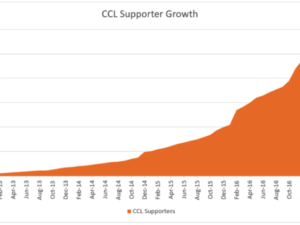Baseball: The common ground on climate change
By Steve Valk
In a famous monologue from “Field of Dreams,” James Earl Jones says, “The one constant through all the years, Ray, has been baseball…This field, this game — it’s a part of our past. It reminds us of all that once was good, and it could be again.”
Turns out it can also bridge the political divide when it comes to explaining the impact of climate change.
CCL volunteer Bruce Northridge, a retired U.S. Navy oceanographer, was in a meeting last year with a city official in Bay St. Louis, Mississippi, who was planning new boat ramps. The city planner was having trouble nailing down water levels, critical information in building boat ramps. Bruce tried to explain that because of climate change, sea levels are continually rising, and storms like Katrina produce overwhelming surges that are getting worse and worse. The minute he heard the term “climate change,” the official, a Republican, said, “I don’t want to go there.”
That was when Bruce seized on a baseball analogy to explain what was happening. He revisited that analogy in a recent op-ed published in the Seacoast Echo. After citing the unusual destructive force of several catastrophic events in the region, he compared these anomalies to what happened during the steroid era in baseball:
From 1927 thru 1998, only two players in major league baseball – Babe Ruth and Roger Maris – were able to hit 60 home runs in a season. From 1998 to 2001, it happened seven more times! Investigations that followed showed that Mark McGwire and Barry Bonds and Sammy Sosa were “juicing.” They were taking performance-enhancing drugs that gave them excess energy. They still had to have the skill to hit a major league fastball (the conditions that create a hurricane still had to exist for Katrina to happen), but when they hit it – it had that much extra “juice” to make it that much more memorable. Yes, we’ve had hurricanes before. And McGwire and Bonds and Sosa had hit home runs before. It’s just that it was more likely that a specific home run in their juicing years was the result of their “excess energy.” Similarly, whether it’s Katrina or [Hurricane] Harvey or [the tornado at] Rolling Fork, one can’t say that it was due to Climate Change. But we can say that it’s more likely.
When he used that metaphor with the Republican city planner, the tone of the meeting instantly shifted. That’s because the official was a big baseball fan. Susan Adams, CCL’s Third Coast Regional Coordinator who was in the meeting, told Bruce that the planner’s eyes grew wide when he started hearing about home runs and players being juiced on steroids.
Bruce says the analogy continues to come in handy when talking to Republicans. “We keep using this. That 26-foot storm surge from Katrina? Let’s call it global excess energy.”
When it comes to the number of home runs in major league baseball, juicing the players isn’t the only factor that can produce more long balls. A juiced atmosphere can also send more balls flying out of the park.
Earlier this spring, a report came out that analyzed home runs over the past 60 years and found that 1 percent of today’s home runs can be attributed to global warming. That’s because warmer temperatures make the air less dense, offering less resistance when the ball leaves the bat.
The baseball analogy to explain climate change has come full circle. Now climate change can explain what happens in baseball.




